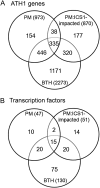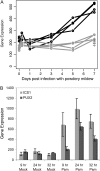Temporal global expression data reveal known and novel salicylate-impacted processes and regulators mediating powdery mildew growth and reproduction on Arabidopsis
- PMID: 19176722
- PMCID: PMC2649394
- DOI: 10.1104/pp.108.132985
Temporal global expression data reveal known and novel salicylate-impacted processes and regulators mediating powdery mildew growth and reproduction on Arabidopsis
Abstract
Salicylic acid (SA) is a critical mediator of plant innate immunity. It plays an important role in limiting the growth and reproduction of the virulent powdery mildew (PM) Golovinomyces orontii on Arabidopsis (Arabidopsis thaliana). To investigate this later phase of the PM interaction and the role played by SA, we performed replicated global expression profiling for wild-type and SA biosynthetic mutant isochorismate synthase1 (ics1) Arabidopsis from 0 to 7 d after infection. We found that ICS1-impacted genes constitute 3.8% of profiled genes, with known molecular markers of Arabidopsis defense ranked very highly by the multivariate empirical Bayes statistic (T(2) statistic). Functional analyses of T(2)-selected genes identified statistically significant PM-impacted processes, including photosynthesis, cell wall modification, and alkaloid metabolism, that are ICS1 independent. ICS1-impacted processes include redox, vacuolar transport/secretion, and signaling. Our data also support a role for ICS1 (SA) in iron and calcium homeostasis and identify components of SA cross talk with other phytohormones. Through our analysis, 39 novel PM-impacted transcriptional regulators were identified. Insertion mutants in one of these regulators, PUX2 (for plant ubiquitin regulatory X domain-containing protein 2), results in significantly reduced reproduction of the PM in a cell death-independent manner. Although little is known about PUX2, PUX1 acts as a negative regulator of Arabidopsis CDC48, an essential AAA-ATPase chaperone that mediates diverse cellular activities, including homotypic fusion of endoplasmic reticulum and Golgi membranes, endoplasmic reticulum-associated protein degradation, cell cycle progression, and apoptosis. Future work will elucidate the functional role of the novel regulator PUX2 in PM resistance.
Figures





Similar articles
-
N-hydroxypipecolic acid and salicylic acid play key roles in autoimmunity induced by loss of the callose synthase PMR4.Plant Physiol. 2025 Apr 30;198(1):kiaf163. doi: 10.1093/plphys/kiaf163. Plant Physiol. 2025. PMID: 40372133
-
BAH1/NLA, a RING-type ubiquitin E3 ligase, regulates the accumulation of salicylic acid and immune responses to Pseudomonas syringae DC3000.Plant Physiol. 2008 Oct;148(2):1032-41. doi: 10.1104/pp.108.124529. Epub 2008 Aug 27. Plant Physiol. 2008. PMID: 18753285 Free PMC article.
-
TCP transcription factors are critical for the coordinated regulation of isochorismate synthase 1 expression in Arabidopsis thaliana.Plant J. 2015 Apr;82(1):151-62. doi: 10.1111/tpj.12803. Plant J. 2015. PMID: 25702611
-
Arabidopsis local resistance to Botrytis cinerea involves salicylic acid and camalexin and requires EDS4 and PAD2, but not SID2, EDS5 or PAD4.Plant J. 2003 Jul;35(2):193-205. doi: 10.1046/j.1365-313x.2003.01794.x. Plant J. 2003. PMID: 12848825
-
PROHIBITIN3 Forms Complexes with ISOCHORISMATE SYNTHASE1 to Regulate Stress-Induced Salicylic Acid Biosynthesis in Arabidopsis.Plant Physiol. 2018 Mar;176(3):2515-2531. doi: 10.1104/pp.17.00941. Epub 2018 Feb 1. Plant Physiol. 2018. PMID: 29438088 Free PMC article.
Cited by
-
Alternative splicing of a multi-drug transporter from Pseudoperonospora cubensis generates an RXLR effector protein that elicits a rapid cell death.PLoS One. 2012;7(4):e34701. doi: 10.1371/journal.pone.0034701. Epub 2012 Apr 5. PLoS One. 2012. PMID: 22496844 Free PMC article.
-
Laser microdissection of Arabidopsis cells at the powdery mildew infection site reveals site-specific processes and regulators.Proc Natl Acad Sci U S A. 2010 Jan 5;107(1):460-5. doi: 10.1073/pnas.0912492107. Epub 2009 Dec 14. Proc Natl Acad Sci U S A. 2010. PMID: 20018666 Free PMC article.
-
Engineering plant immune circuit: walking to the bright future with a novel toolbox.Plant Biotechnol J. 2023 Jan;21(1):17-45. doi: 10.1111/pbi.13916. Epub 2022 Sep 27. Plant Biotechnol J. 2023. PMID: 36036862 Free PMC article. Review.
-
Identification of genes specifically or preferentially expressed in maize silk reveals similarity and diversity in transcript abundance of different dry stigmas.BMC Genomics. 2012 Jul 2;13:294. doi: 10.1186/1471-2164-13-294. BMC Genomics. 2012. PMID: 22748054 Free PMC article.
-
Loss of compatibility might explain resistance of the Arabidopsis thaliana accession Te-0 to Golovinomyces cichoracearum.BMC Plant Biol. 2012 Aug 11;12:143. doi: 10.1186/1471-2229-12-143. BMC Plant Biol. 2012. PMID: 22883024 Free PMC article.
References
-
- Alonso JM, Stepanova AN, Leisse TJ, Kim CJ, Chen H, Shinn P, Stevenson DK, Zimmerman J, Barajas P, Cheuk R, et al (2003) Genome-wide insertional mutagenesis of Arabidopsis thaliana. Science 301 653–657 - PubMed
-
- Benjamini Y, Hochberg Y (1995) Controlling the false discovery rate: a practical and powerful approach to multiple testing. J R Statist Soc Ser B Methodological 57 289–300
-
- Blanco F, Garreton V, Frey N, Dominguez C, Perez-Acle T, Van der Straeten D, Jordana X, Holuigue L (2005) Identification of NPR1-dependent and independent genes early induced by salicylic acid treatment in Arabidopsis. Plant Mol Biol 59 927–944 - PubMed
-
- Bolstad BM, Irizarry RA, Astrand M, Speed TP (2003) A comparison of normalization methods for high density oligonucleotide array data based on variance and bias. Bioinformatics 19 185–193 - PubMed
Publication types
MeSH terms
Substances
Grants and funding
LinkOut - more resources
Full Text Sources
Other Literature Sources
Molecular Biology Databases

